 Hey there!
Hey there!
When we knew we were going to go to Rwanda, we had the mission of seeing gorillas. There are only a couple of places in the world where you can see gorillas – because there are on 880 gorillas in the world. So when we had the opportunity, now seemed the moment to seize it. Furthermore, Marcus has wanted to see gorillas since he was 5 years old. And who am I to rain on that 50 year-old dream?
In order to see the gorillas, we needed to arrange permits, as well as figure out how to travel the 9-12 hours to Bwindi. This is the high season, and finding permits proved to be more difficult than we had expected. They were all sold out. Ooops. We didn’t come this far to not see gorillas. Maria called a friend of hers, and he called the Ugandan Wildlife Council. Next thing you know, we had five permits to see the research group of gorillas on the 30th. Permits are $500 a piece. Not cheap. But if we visited from the Rwanda side, it would cost $750, and the Ugandan price goes up to $600 in January. For $500, we get a guide who will lead us into the Impenetrable Forest of Uganda – yes, it’s called the Impenetrable Forest for a reason – and we’ll trek until we come across our gorilla group. It could take 15 minutes, or it could eight hours. However, they’re 99% sure you’ll see the gorillas. You get to spend one hour with them, and then you trek back to the safari lodge.
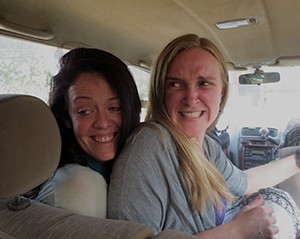 Now for arranging the travel. We sat with the map of Uganda in front of us, looking the relatively few number of roads. The most interesting route took us through Queen Elizabeth National Park. That meant we could actually safari on the way to Bwindi. Bonus round!
Now for arranging the travel. We sat with the map of Uganda in front of us, looking the relatively few number of roads. The most interesting route took us through Queen Elizabeth National Park. That meant we could actually safari on the way to Bwindi. Bonus round!
And the car? Another one of Maria’s friends stepped up. Poley and his driver, Kula, drove from Kissese to pick us up. Unfortunately, they didn’t bring a safari car. They brought a Toyota station wagon. Seven people and their luggage in a small Toyota station wagon… it was a recipe for disaster ahead. Mark and I wound up in the jump seat in the back, and Maria, Corey, and Salim shared the second seat – very tight. Poley and Kula had the only two comfortable seats.
As it turns out, Queen Elizabeth National Park is a great place to safari. Without doing a formal drive, we saw hundreds of animals from elephants to buffalo, wart hogs, and impala. Every 2-3 minutes we’d holler “STOP” to Kula, and then he’d stop, back up a little, pull forward a little, back up a little – angling for the best pictures, which isn’t easy when you’re crammed in the back of a Toyota station wagon.
 We’d decided to stay in the Mweya Lodge – a beautiful place within Queen Elizabeth Park itself. OK, so it was my choice. I think Corey and Maria would have camped in a less expensive place outside the park, if they’d had their way. But, my philosophy was, if we’re going to go there and do this, then let’s really do this! As we pulled up to the lodge, a family of wart hogs, including three babies, were grazing in front of the lodge. Mark about lost his mind. He took pictures of them for hours. The rest of our group had other plans. Corey and Salim headed to the spa. Maria, Poley, and I headed to our little house. We were all sharing a three bedroom cottage. We ordered wine and cheese and sat on the back patio watching the sun go down.
We’d decided to stay in the Mweya Lodge – a beautiful place within Queen Elizabeth Park itself. OK, so it was my choice. I think Corey and Maria would have camped in a less expensive place outside the park, if they’d had their way. But, my philosophy was, if we’re going to go there and do this, then let’s really do this! As we pulled up to the lodge, a family of wart hogs, including three babies, were grazing in front of the lodge. Mark about lost his mind. He took pictures of them for hours. The rest of our group had other plans. Corey and Salim headed to the spa. Maria, Poley, and I headed to our little house. We were all sharing a three bedroom cottage. We ordered wine and cheese and sat on the back patio watching the sun go down.
All of the sudden we heard a growl coming from the bushes not 20 feet from our patio.
 Ohmygod that was close. Maria and I bolted for the cottage. Poley just looked at us like we were insane. “It’s probably just a wart hog,” says Poley. The bushes shook. More animal sounds. “It’s a hippo down in the lake,” say’s Poley. The bushes shake some more. There’s no way that this animal is down at the lake. And then there’s another cry. Now, I may not be an African, but I sure know an elephant when I hear one. So does Maria.
Ohmygod that was close. Maria and I bolted for the cottage. Poley just looked at us like we were insane. “It’s probably just a wart hog,” says Poley. The bushes shook. More animal sounds. “It’s a hippo down in the lake,” say’s Poley. The bushes shake some more. There’s no way that this animal is down at the lake. And then there’s another cry. Now, I may not be an African, but I sure know an elephant when I hear one. So does Maria.
“It’s a wild elephant,” she says.
“No,” answers Poley. “It’s probably just a human with a horn.” Right. Because it’s more likely that there’s a jokester with a trumpet in our bushes than that an elephant is eating dinner.
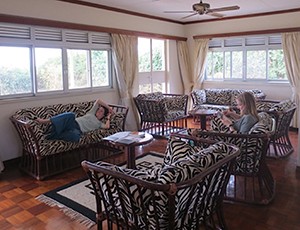 After the sun went down, we decided to head back to the main lodge to join the others for dinner. As we’re waiting for the golf cart to come get us (because you’re not suppose to walk alone at night in the park), I decided to check out the cottage next door. It was a little higher up than ours, and I thought it might have a better view. So I went through the break in the bushes and headed for their front porch. About halfway there, I came across a big pile of fresh elephant dung. I’d been looking at my feet, picking my way across the stones to the cottage. At the elephant dung, I looked up. Immediately in front of me were four elephants, two enormous elephants and two babies. Wild. Elephants. I slowly backed up, back through the bushes.
After the sun went down, we decided to head back to the main lodge to join the others for dinner. As we’re waiting for the golf cart to come get us (because you’re not suppose to walk alone at night in the park), I decided to check out the cottage next door. It was a little higher up than ours, and I thought it might have a better view. So I went through the break in the bushes and headed for their front porch. About halfway there, I came across a big pile of fresh elephant dung. I’d been looking at my feet, picking my way across the stones to the cottage. At the elephant dung, I looked up. Immediately in front of me were four elephants, two enormous elephants and two babies. Wild. Elephants. I slowly backed up, back through the bushes.
“Maria!!!!” I whispered loudly. “Elephants. Here. Elephants.” She followed me through the bushes and saw the elephants. Although the babies continued to eat the bushes like we weren’t even there, the ears on the larger elephants flapped wildly at us. She immediately pulled me back toward our cottage. Maria is better at identifying danger than I am. The elephants retreated into the bush.
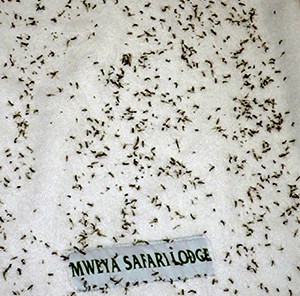 We learned another important lesson in Queen Elizabeth Park. Don’t leave your lights on at night. The housekeeper had closed all of the curtains and windows when we got home. But someone took a shower, and decided to open the window (which has a screen) to let the steam out. And then the light was left on in the shower room. The entire room was filled with flies the next morning. These flies are not the house flies that plague Americans. They’re smaller, flea looking flies that only live about 24 hours. So there were live flies all over the walls, and dead flies filling the floor and the bathtub. There were so many flies that they had escaped under the door and lined the floor around the bathroom. Flies on every surface. It was like something out of an Alfred Hitchcock movie. Eww.
We learned another important lesson in Queen Elizabeth Park. Don’t leave your lights on at night. The housekeeper had closed all of the curtains and windows when we got home. But someone took a shower, and decided to open the window (which has a screen) to let the steam out. And then the light was left on in the shower room. The entire room was filled with flies the next morning. These flies are not the house flies that plague Americans. They’re smaller, flea looking flies that only live about 24 hours. So there were live flies all over the walls, and dead flies filling the floor and the bathtub. There were so many flies that they had escaped under the door and lined the floor around the bathroom. Flies on every surface. It was like something out of an Alfred Hitchcock movie. Eww.
On the way out of the park, Corey told us that her goal was to see leopards. A few of the guests at the lodge had seen leopards outside their room the night before. (Hmmmm. I guess that confirmed why we shouldn’t have walked to the lodge when the golf cart didn’t come.) Leopards are one of the big five, and the only one that we hadn’t seen yet. I told her that we would see them, but they’d be in a tree. Another animal that Queen Elizabeth has are the tree-climbing lions. Maria was hoping to see more lions. And me? I’m a giraffe fan. I just wanted to see giraffes.
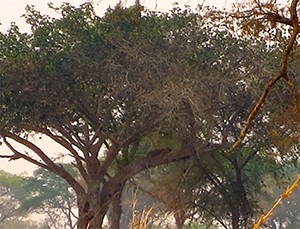 It wasn’t too long before Salim yelled, “STOP! Tree lion!” Sure enough. We could see the big cat lying in a tree about 50 yards from the road. How Salim spotted it is still a mystery to me. It was close enough to see the outline, but not close enough to see detail. So Maria took a picture with my camera and we zoomed in on it.
It wasn’t too long before Salim yelled, “STOP! Tree lion!” Sure enough. We could see the big cat lying in a tree about 50 yards from the road. How Salim spotted it is still a mystery to me. It was close enough to see the outline, but not close enough to see detail. So Maria took a picture with my camera and we zoomed in on it.
Mark, who couldn’t really see it at all, said, “Oh sure, now I see it. Why do tree lions have spots?” Mark has become famous for his questions. The day before at the equator, he asked Sara, “Why is this potato yellow?” Sara answered, “We call it a banana.” Oh. Sure. That’s why! This time, Mark had noticed that it wasn’t a tree lion. It was a leopard. Seeing leopards is rare, so we were all fairly high on animal spotting at that point. And everyone decided that I had the magic of being able to produce/predict animals, and Salim had the magic of spotting them.
The drive from Queen Elizabeth to Bwindi was supposed to take around six hours. That’s if you were doing it in a Safari vehicle. These are all one-lane dirt roads, and they’re much better in a 4-wheel drive. After five hours, we stopped for lunch, and Moses, who runs the lodge at Bwindi, told us by phone it would be another four hours. From the map, it looked as if we were very close. We google-mapped it on Salim’s phone. The directions were hysterical. Roads don’t have names in this part of the world. So the directions read as “turn left, turn left, turn left, turn left, turn left, turn left, veer right, turn left, turn left, turn left.” It was only 65 kilometers – less than 30 miles. There was no way that would take us four hours…
It took us 5. 5 hours to go 29 miles. How? Well, first it started to rain. So the luggage that was on top of the car had to be put on top of us inside the car. And then the road gradually got worse and worse. Kula would get stuck, and we’d all have to get out to remove the weight. We’d walk ahead, he’d get un-stuck, and drive ahead, and we’d reload. Let me tell you what it’s like for a car-sick prone person like myself to spend 10 hours in the backseat of a Toyota station wagon… It’s not fun. Maria looked back at Mark and I in our misery and said, “It looks like you want to click your heels together and go home.”
“We probably would IF we could get our heels together,” I quipped. “But there’s a guitar and a five gallon water jug between my heels, and two drums and a backpack between Mark’s.”
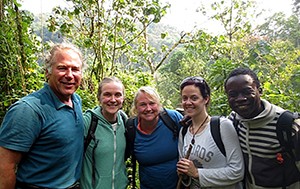 As uncomfortable as it was, Mark and I took it upon ourselves to try to lighten the mood in the car. We started creating the soundtrack for the trip. Everyone joined in. There were the obvious songs like The Road to Nowhere by the Talking Heads, and the Long and Winding Road by the Beatles. Then there were the ones that required making slight changes to the lyrics. Dust in the Wind by Kansas became, Dust in my Eyes. As our Toyota station wagon is sliding perilously toward the edge of steep cliffs in Bwindi’s Impenetrable Forest, we sang Willie Nelson’s On the Road Again: “On the road again. Just can’t wait to get on the road again. I find my pleasure in Bwindi with my friends, and I can’t wait to stay on the road again.” The list of music goes on. You know you’re tired when you’re singing Barry Manilow lyrics to your traveling companions, and trying to find words that rhyme with truck, which aren’t… well, there it is.
As uncomfortable as it was, Mark and I took it upon ourselves to try to lighten the mood in the car. We started creating the soundtrack for the trip. Everyone joined in. There were the obvious songs like The Road to Nowhere by the Talking Heads, and the Long and Winding Road by the Beatles. Then there were the ones that required making slight changes to the lyrics. Dust in the Wind by Kansas became, Dust in my Eyes. As our Toyota station wagon is sliding perilously toward the edge of steep cliffs in Bwindi’s Impenetrable Forest, we sang Willie Nelson’s On the Road Again: “On the road again. Just can’t wait to get on the road again. I find my pleasure in Bwindi with my friends, and I can’t wait to stay on the road again.” The list of music goes on. You know you’re tired when you’re singing Barry Manilow lyrics to your traveling companions, and trying to find words that rhyme with truck, which aren’t… well, there it is.
When we exhausted recorded songs, we began writing our own songs. We had 10 hours in the car after all. We had the Backseat blues; Ode to Julius; Doctors with full bladders… Perhaps we’ll have a concert when we get back to Portland.
And then we arrived at Ruhija Lodge in Bwindi. It was gorgeous. It’s these little cabins built on a hillside, with steep mountains all around it. It smelled like eucalyptus and pine. The best part was that they had hot water, to wash the layers upon layers of dust and dirt off us. Maria said Mark looked like a mad scientist covered in dirt with mussed hair. My face was so dirt-caked that I could no longer make expressions. I washed my hair twice, and when I dried it, the white towel turned brown. Maria said washing her hair was even more difficult. She said “I have to treat my hair like a baby’s butt.” Sure. OK. We scrubbed our bodies, and our luggage, and headed to the main lodge for dinner.
There were some German tourists who had made their trek to see the gorillas earlier that day, while we were making our way toward Bwindi. It took them two hours to reach the gorillas. We would be tracking a different group than them. I said, “I’m shooting for 30 minutes, max.” Hey, why not? Some of the drivers and people who work at the lodge told us that they’ve seen gorillas when they’re crossing the road! While 30 minutes would be great, I just hoped that we weren’t going to be one of the groups who walked for eight hours and ended up seeing them with flashlights on the trek home.
Guess you’ll have to wait for the next letter to know what happened…
Love from Bwindi in Uganda!
Heather